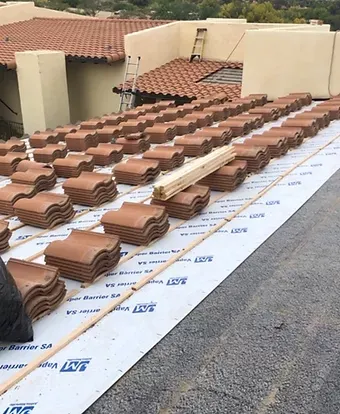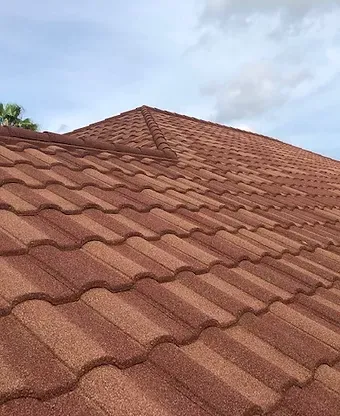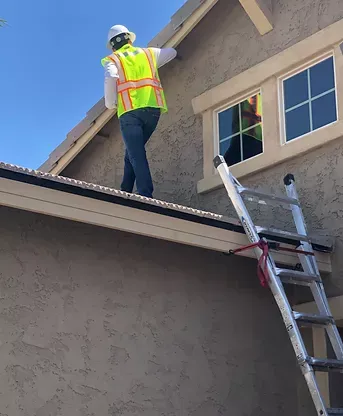TPO vs. PVC Roofing: Which is Best for Southwest Florida Businesses?
TPO vs. PVC Roofing: Which is Best for Southwest Florida Businesses?
Introduction to Single-Ply Roofing Systems
Single-ply roofing systems have become a go-to choice for commercial buildings, especially in regions like Southwest Florida. These systems are made from flexible sheets of synthetic material that provide excellent protection against the elements. TPO (Thermoplastic Polyolefin) and PVC (Polyvinyl Chloride) are two of the most popular types of single-ply membranes. Unlike traditional built-up roofs or metal roofing , single-ply options are lightweight, easy to install, and highly durable. This makes them ideal for businesses looking for reliable, long-term solutions.
Businesses in Southwest Florida particularly favor TPO and PVC because they offer superior performance in extreme weather conditions. Both materials are designed to withstand high temperatures, heavy rains, and strong winds, which are common in this part of the country. With their energy-efficient properties and low maintenance requirements, these roofing systems help business owners save money while ensuring their properties remain protected year-round.
What Is TPO Roofing?
TPO roofing is a single-ply membrane made from a blend of polypropylene and ethylene-propylene rubber. It’s known for its flexibility, durability, and affordability, making it a top choice for many commercial properties. The material is typically installed in large rolls and heat-welded at the seams to create a watertight seal. This method ensures minimal chances of leaks , even during heavy storms. TPO roofs are often white or light-colored, which enhances their ability to reflect sunlight and reduce cooling costs—a major advantage in hot climates like Southwest Florida.
One of the reasons TPO is so popular among businesses in this region is its balance of cost-effectiveness and performance. It’s resistant to mold, algae, and punctures, which are common concerns in humid environments. Additionally, TPO’s reflective surface helps lower energy bills by keeping buildings cooler. For businesses looking for a budget-friendly yet reliable roofing solution, TPO is an excellent option to consider.
What Is PVC Roofing?
PVC roofing is another single-ply membrane that has gained popularity for its exceptional durability and versatility. Made from layers of polyester reinforcement and PVC plastic, this material is highly resistant to chemicals, fire, and extreme weather conditions. Like TPO, PVC is installed in large sheets and heat-welded at the seams for maximum strength and waterproofing. Its smooth surface also makes it easier to clean and maintain over time.
In Southwest Florida, PVC roofing is especially valued for its ability to handle harsh environmental factors. Its chemical resistance makes it a preferred choice for restaurants and industrial facilities with rooftop exhaust systems. Additionally, PVC’s reflective properties contribute to energy savings by reducing heat absorption. While it may come with a higher upfront cost compared to TPO, its longevity and performance make it a worthwhile investment for many businesses.
Climate Challenges in Southwest Florida
Southwest Florida presents unique challenges for roofing systems due to its intense sun, high humidity, and frequent storms. The region experiences some of the highest UV exposure in the country, which can cause traditional roofing materials to degrade quickly. High humidity levels also increase the risk of mold and mildew growth, making it essential to choose a roof that can resist moisture-related issues.
Hurricanes and tropical storms are another major concern for businesses in this area. Strong winds and heavy rainfall can wreak havoc on roofs that aren’t designed to withstand such forces. As a result, selecting a roofing system that offers excellent wind uplift resistance and storm durability is crucial. Both TPO and PVC have features that address these challenges, but understanding their differences will help business owners make informed decisions.
Performance Comparison: TPO vs. PVC in Southwest Florida
When it comes to performance in Southwest Florida’s challenging climate, both TPO and PVC have their strengths. TPO excels in UV reflectivity, helping to keep buildings cooler and reducing cooling costs during the scorching summer months. Its flexibility allows it to expand and contract with temperature changes, minimizing the risk of cracks or splits caused by thermal cycling.
PVC, on the other hand, stands out for its superior resistance to chemicals and punctures. This makes it particularly well-suited for businesses exposed to harsh substances or those requiring frequent rooftop access. Additionally, PVC’s robust composition gives it an edge in handling hurricane-force winds and heavy rains without sustaining damage. Over time, both materials demonstrate impressive longevity when properly maintained , though PVC tends to hold up slightly better under extreme conditions.
Ultimately, the choice between TPO and PVC depends on specific business needs and priorities. For example, companies focused on energy efficiency might lean toward TPO, while those needing added durability and chemical resistance may prefer PVC. Consulting with experienced professionals, such as those at 4 Peaks Roofing, can provide valuable insights tailored to your property’s unique requirements.
Energy Efficiency and Cost Savings
Both TPO and PVC roofing systems are celebrated for their energy-saving capabilities thanks to their highly reflective surfaces. By bouncing back sunlight rather than absorbing it, these materials significantly reduce the amount of heat transferred into buildings. This translates to lower air conditioning costs, which is a major benefit for businesses operating in Southwest Florida’s relentless heat.
While both options deliver excellent energy efficiency, there are subtle differences worth noting. TPO’s affordability often makes it the more budget-friendly choice upfront, but PVC’s longer lifespan could lead to greater long-term savings. Business owners should weigh these factors carefully when deciding which system aligns best with their financial goals and operational demands.
Durability and Lifespan
The durability of a roofing system is critical for businesses seeking long-lasting protection. TPO roofs typically last between 15 to 20 years when installed correctly and maintained regularly. They’re resistant to tears, punctures, and impact damage , making them suitable for areas prone to hail or debris from storms. However, their lifespan can be shorter if not properly cared for or if subjected to excessive foot traffic.
PVC roofs generally boast a longer lifespan, ranging from 20 to 30 years. Their reinforced structure provides superior strength and resistance to wear and tear. This makes them a smart investment for businesses that require frequent rooftop access or operate in industries with demanding conditions. Regardless of the material chosen, partnering with a trusted contractor like 4 Peaks Roofing ensures proper installation and ongoing maintenance to maximize the roof’s longevity.
Chemical and Fire Resistance
PVC roofing shines when it comes to chemical resistance, making it the preferred option for businesses dealing with oils, fats, or other corrosive substances. Restaurants, manufacturing plants, and industrial facilities often opt for PVC because it won’t degrade when exposed to these materials. This feature alone can reduce repair costs over time.
Fire resistance is another area where both TPO and PVC excel, though PVC takes the lead. Many PVC membranes are rated Class A for fire resistance, offering the highest level of protection against flames. TPO also performs admirably in this category, but its fire-resistant additives may not match the inherent qualities of PVC. For businesses prioritizing safety and compliance with fire codes, PVC’s advanced protection is a compelling reason to choose it.
Installation and Maintenance Considerations
The installation process for TPO and PVC roofs involves similar techniques, such as heat welding seams to ensure watertight seals. However, PVC requires specialized equipment and expertise due to its thicker composition. This means working with experienced contractors , like those at 4 Peaks Roofing, is vital to achieving a flawless installation. Proper technique is essential to avoid issues like seam separation or leaks down the line.
Maintenance routines for both systems are relatively straightforward, focusing on regular inspections and clearing debris. TPO may require more attention to prevent algae growth in humid climates, while PVC’s smooth surface naturally resists dirt buildup. Preventative maintenance programs can catch small problems before they escalate, ensuring either roofing type continues to perform optimally for years to come.
Cost Comparison: Upfront and Long-Term
TPO roofing generally has a lower upfront cost compared to PVC , making it an attractive option for businesses on tighter budgets. Installation costs are typically less expensive due to the material’s lighter weight and simpler handling. Additionally, warranties for TPO roofs often cover 15 to 20 years, providing peace of mind for business owners.
PVC, while pricier initially, offers potential long-term savings through its extended lifespan and reduced need for repairs. Its durability and resistance to various stressors mean fewer replacements and lower maintenance expenses over time. When considering total lifecycle costs, including installation, upkeep, and eventual replacement, PVC may prove to be the more economical choice despite its higher starting price.
Use Cases: Which Businesses Benefit Most from TPO or PVC?
Different industries benefit from the unique advantages of TPO and PVC roofing. Warehouses and office buildings often gravitate toward TPO due to its affordability and energy efficiency. These properties typically don’t face chemical exposure or heavy rooftop activity, allowing TPO’s strengths to shine without limitations.
In contrast, restaurants, hospitals, and manufacturing facilities frequently choose PVC for its unmatched chemical and fire resistance. These industries often deal with grease, exhaust fumes, or hazardous materials, making PVC’s robust composition indispensable. Understanding the specific needs of your business will guide you toward the most suitable roofing solution.
Choosing the Right Contractor in Southwest Florida
Selecting a qualified contractor is just as important as choosing the right roofing material. Look for licensed professionals with extensive experience installing both TPO and PVC systems. A reputable company like 4 Peaks Roofing will assess your property’s unique needs and recommend the best course of action based on your budget and goals.
Insurance coverage and warranty options should also factor into your decision. A trustworthy contractor will provide detailed information about guarantees and service plans to protect your investment. By partnering with experts who understand the nuances of Southwest Florida’s climate, you can ensure your new roof performs flawlessly for decades.
FAQs: TPO vs. PVC Roofing for Southwest Florida Businesses
Which roofing system lasts longer in Florida: TPO or PVC?
Is one system more resistant to hurricanes and strong winds?
How do TPO and PVC roofing systems handle ponding water?
Is there a significant difference in energy savings between TPO and PVC?
What is the price difference between TPO and PVC roofing?
Conclusion: Making the Right Choice for Your Business
Choosing between TPO and PVC roofing ultimately comes down to understanding your business’s unique needs and priorities. Both systems offer excellent performance in Southwest Florida’s challenging climate, but their differences in cost, durability, and specialized features make them suited to different applications. Whether you prioritize energy efficiency, chemical resistance, or long-term value, there’s a solution that fits your goals.
To ensure you make the best decision for your property, consult with local roofing experts who understand the intricacies of TPO and PVC systems. Request a consultation with 4 Peaks Roofing today to explore which option is best for your Southwest Florida business. Investing in the right roof now will provide lasting protection and cost efficiency for years to come.




